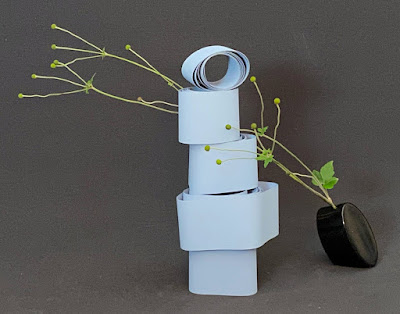Hello all,
Well, here we are in lockdown for the fourth time and, although we know the reasons for it and we know what to do, it's difficult not to be frustrated. Just last weekend I had three events cancelled. One of them was a Sogetsu event - a day of workshops with a guest presenter from Brisbane, Vernisher Wooh. Like everyone who booked for this event, I was looking forward to the social as well as the ikebana aspect of it and am, therefore, quite disappointed.
Although I could not meet up with my ikebana colleagues, I could still make the arrangements that Vernisher had chosen for the workshops.
The first was making an arrangement 'Using One Kind of Material'. A quick walk around the garden and I came across a number of suitable materials. My first choice was the mahonia, which is in full flower and has interestingly shaped branches because the willow tree fell on it some years ago and bent it. This means that some of the branches grow horizontally. I picked a rather large branch from which I removed superfluous leaves and a couple of side branches. As the stem is horizontal, it sits quite high in the container and requires a vertical fixture to keep it in position.
Mahonia stems with leaves can last a very long time in water. In marked contrast, the flowers start to drop the very next day. After the third day, I got tired of vacuuming yellow flowers from the table and removed the flowers all together. The stems still look great.
I couldn't resist making a second arrangement with these leucodendron stems, which have interesting curves. I wanted to emphasise these curves and the colour, so I removed more than half the leaves that were growing along the stems. I removed all of the leaves at the bottom keeping the lines at the entry into the container clean.
The second exercise was to have been a combination of two themes - An ikebana arrangement using materials representing the autumn/winter transition and incorporating Book 4 Lesson 20, 'You in Ikebana'.
I gave considerable thought to this challenge, Autumnal arrangements bring to mind branches with leaves changing colours. This almost invariably leads to a naturalistic arrangement, which is all well and good but, in this case I had to incorporate 'Me' in this arrangement. Although I love and practice all forms of ikebana, the style I'm most drawn to is the minimalist/modern one. Here's what I came up with:
The stems are from my weeping elm. The one on the right sits a little further back from the one one the left, giving some depth. Unfortunately, this is lost in the photograph, making the arrangement look a little too minimalist. I, actually like it this way but I know that some of you would prefer more. So, I went out into the garden looking for something, other than a flower to add. The white camellia bud was something I was prepared to accept.
Last week, when travel was still allowed, I came across a flowering hakea tree that was almost past its best. I was able to find three stems with good flowers and some buds and I brought them home. I reused the chrysanthemums that Toula gave me to complete this simple but, for me, pleasing arrangement.
This next arrangement goes under the category of playing. The dried piece was lying around in the ikebana room when I picked it up to take to the store room. It never made it. I placed it in this, self made container, then had to consider materials to add to it. The container has a narrow neck, so thin stemmed materials would be best. Enter the crucifix orchid, of which I used three stems.
I mentioned my prunus mume, Japanese flowering apricot, last week because it is just coming into flower. This seems quite unseasonal because the blossoms look like spring blossoms but they arrive at the beginning of winter. I wanted to use this material for a large arrangement in my newly acquired container, a Mothers' Day present from my children and because I like them best when they are just starting to flower. When the flowers are fully open, the tree looks wonderful but in an arrangement the stems are not so good, as they keep dropping petals.














































